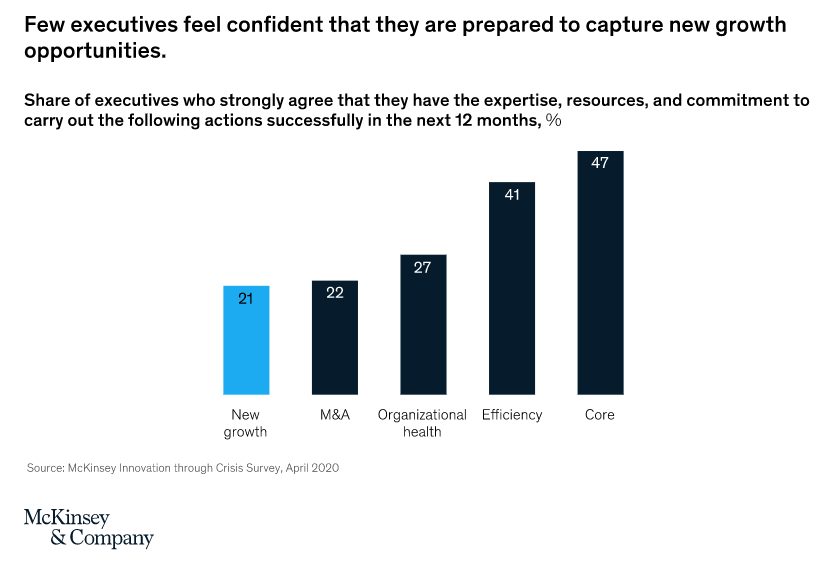An unseen enemy, COVID-19, has turned businesses big and small upside down. Most are simply trying to survive, making this crisis the perfect time to prioritize innovation and propel your organization’s position in the marketplace. Read on to find out why innovation is so critical during a time of crisis and how you can get started.
We’re all familiar with the story. A young Isaac Newton was sitting beneath an apple tree, when suddenly – bonk! – an apple hits him on the head. “Aha!” he shouts, and in a flash, he discovers that the very same force that brought the apple crashing toward the ground also keeps the moon from falling toward the Earth and the Earth from falling toward the sun.
Some of the greatest innovations of all time were discovered and developed during times of crisis. When the Great Plague of London ravaged through the British city beginning in 1665, Isaac Newton was just a student at Trinity College in Cambridge. Isolated in quarantine, the philosopher engaged in groundbreaking discoveries, including that of gravity, and the rest is history.
In more modern times, World War I sparked a number of remarkable innovations. Although the zipper was first conceived during the 19th century, the technology wasn’t fine-tuned or widely adopted until the global conflict when it was used for flight jackets and money belts worn by U.S. sailors, who lacked pockets in their uniforms. Born out of necessity during a dark time in history, we now have one of the best and most useful inventions.
“Invention, it must be humbly admitted, does not consist in creating out of void, but out of chaos.” – Mary Shelley, English novelist
It is in times of crises that harnessing creativity is most crucial. Ironically, however, business leaders tend to operate oppositely with many rotely implementing a standard survival playbook involving cost and staff reductions. Indeed, such survival tactics might be warranted, but business leaders should not stop there. Instead, they should leverage a crisis as an opportunity to outperform, and outlast, competitors and market conditions.
In fact, global management consulting firm, McKinsey & Company, discusses this idea in great length in its article, Innovation in a crisis: Why it is more critical than ever. We have summarized and provided direct excerpts from the article with key points for busy business leaders and professionals to save time.
What is Limiting Companies from Innovating?
McKinsey’s recent survey with business leaders recently found that, during a crisis, many companies are deprioritizing innovation to concentrate on four things:
- Shoring up their core business.
- Pursuing known opportunity spaces.
- Conserving cash and minimizing risk.
- Waiting until “there is more clarity.”
Interestingly though, they also found that 90% of executives believe that the COVID-19 crisis will fundamentally change the way they do business over the next five years. However, only 21% felt they have the expertise, resources, and commitment to face the challenge.


However, businesses simply cannot become myopic in just focusing on the present and operate as they have in the past. What made a company successful historically may no longer be possible during or after a crisis. Customers may struggle to pay. Channels may have radically shifted to accommodate new needs or workaround new constraints. A stable regulatory context may have changed, potentially creating opportunities that never existed before. The assumptions that supported years of steady, predictable growth may no longer be valid.
“Firms are not going to be able to discount their way out of this,” Nicole Auerbach, founding partner of ElevateNext, a firm aligned with law company Elevate Services, said. “The budget cuts and staffing cuts that law departments are facing are going to require them to do the business of law much differently. And that’s going to require innovation.”
“Other than maybe the go-to, ‘bet the company’ firms that can sustain themselves the way they’ve always been doing things, those in the industry who don’t innovate are going to suffer tremendously,” Auerbach said.

The Big Pivot
During the COVID-19 crisis, there have been many stories of ingenuity and heroic tales of companies shifting their focus to meet urgent consumer needs. One of our favorite stories includes local distilleries using their industry expertise and access to resources to make alcohol-based hand sanitizers during the shortage. In another example, clothing stores like The Children’s Place quickly shuttered many of their brick-and-mortar stores throughout the country to save expenses from rent and other overhead and switched to an online-only business. This rang as welcome news for parents stuck at home with kids and other consumers not desiring to shop in a traditional mall in the immediate future. Wholesalers that traditionally sold food and supplies to restaurants found themselves directly selling to consumers for the first time. In similar fashion, some dance and performing arts studios invested in technology and transitioned all their classes online via Zoom. This enabled the studios open their doors to many more students, not just locally, but all across the globe.
Companies that were able to pivot and act quickly are finding new business opportunities that they would have never dreamed of before. To do this, especially in a time of crisis, more urgent actions to take include:
- Adapting the core to meet shifting customer needs.
- Identifying and quickly addressing new opportunity areas being created by the changing landscape.
- Reevaluating the innovation initiative portfolio and ensuring resources are allocated appropriately.
- Building the foundation for post-crisis growth in order to remain competitive in the recovery period.
Moreover, research has shown that companies that invest in innovation outperformed their peers not only through-crisis but also outperformed the market by 30% in post-crisis years as well.

Simply put, crisis or not, the ability to develop, deliver, and scale new products, services, processes, and business models rapidly is a muscle that virtually every organization needs to strengthen.
Critical Practices That Have the Greatest Impact on Innovation
In earlier research, McKinsey introduced the Eight Essentials of Innovation — the critical practices that have the most significant impact on innovation success. They subsequently found that mastering the Eight Essentials leads to significantly higher performance, with organizations that excel at most of these practices delivering 2.4 times higher economic profit. Mastering these innovation essentials is even more critical now, as companies prepare to return to growth coming out of the crisis.
Here is a quick overview of all Eight Essentials:

The immediate challenge is motivating teams to bring intense focus, speed, and agility to delivering new sources of value. Crises are like adrenaline for innovation, causing barriers that once took years to overcome to evaporate in a matter of days. Entrenched orthodoxies on “the way things are done” are replaced with “the new way we do things” almost overnight.
To emerge as leaders from this crisis, companies can rely on the Eight Essentials of Innovation as a formula and a road map for success. While all of the Eight Essentials matter and it’s worthwhile to understand them a whole, research has shown that in times of broad economic stability, two of them — Aspire and Choose — are most important for generating immediate outsized impact. In times of crisis, however, other essentials take on greater significance, suggesting a different order of action. McKinsey’s research recommends prioritizing: Discover, Evolve, and Choose. These three will guide an organization in reorienting its focus, as needed.
Testing for Innovation – Is Your Organization Innovating?

After you have focused on these three essentials, leaders then can address Aspire to reset their guiding “North Star.” Then in later phases, Accelerate and Scale to invest at the right levels and speed given potential changes in end markets, Extend to develop new types of ecosystems, and finally Mobilize to put in place the appropriate talent and incentives to activate the innovation plans.
Hopefully, by narrowing this focus, this gives you enough inspiration to get your organization started on your innovation journey. Stay tuned for Part Two of our Innovation blog series, a practical How-To guide – with step-by-step, actionable processes and tips – on how you can achieve your innovation goals.
Are you feeling inspired? What breakthroughs and “Aha!” opportunities will you and your team seize during this transformative period?
